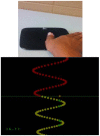Does Location of Tonic Pain Differentially Impact Motor Learning and Sensorimotor Integration?
- PMID: 30250009
- PMCID: PMC6210022
- DOI: 10.3390/brainsci8100179
Does Location of Tonic Pain Differentially Impact Motor Learning and Sensorimotor Integration?
Abstract
Recent work found that experimental pain appeared to negate alterations in cortical somatosensory evoked potentials (SEPs) that occurred in response to motor learning acquisition of a novel tracing task. The goal of this experiment was to further investigate the interactive effects of pain stimulus location on motor learning acquisition, retention, and sensorimotor processing. Three groups of twelve participants (n = 36) were randomly assigned to either a local capsaicin group, remote capsaicin group or contralateral capsaicin group. SEPs were collected at baseline, post-application of capsaicin cream, and following a motor learning task. Participants performed a motor tracing acquisition task followed by a pain-free retention task 24⁻48 h later while accuracy data was recorded. The P25 (p < 0.001) SEP peak significantly decreased following capsaicin application for all groups. Following motor learning acquisition, the N18 SEP peak decreased for the remote capsaicin group (p = 0.02) while the N30 (p = 0.002) SEP peaks increased significantly following motor learning acquisition for all groups. The local, remote and contralateral capsaicin groups improved in accuracy following motor learning (p < 0.001) with no significant differences between the groups. Early SEP alterations are markers of the neuroplasticity that accompanies acute pain and motor learning acquisition. Improved motor learning while in acute pain may be due to an increase in arousal, as opposed to increased attention to the limb performing the task.
Keywords: local pain; motor learning; remote pain; somatosensory evoked potentials (SEPs).
Conflict of interest statement
The authors declare no conflict of interest.
Figures






Similar articles
-
The Interactive Effect of Tonic Pain and Motor Learning on Corticospinal Excitability.Brain Sci. 2019 Mar 16;9(3):63. doi: 10.3390/brainsci9030063. Brain Sci. 2019. PMID: 30884779 Free PMC article.
-
Interactive effect of acute pain and motor learning acquisition on sensorimotor integration and motor learning outcomes.J Neurophysiol. 2016 Nov 1;116(5):2210-2220. doi: 10.1152/jn.00337.2016. Epub 2016 Aug 17. J Neurophysiol. 2016. PMID: 27535371 Free PMC article.
-
The effect of local vs remote experimental pain on motor learning and sensorimotor integration using a complex typing task.Pain. 2016 Aug;157(8):1682-1695. doi: 10.1097/j.pain.0000000000000570. Pain. 2016. PMID: 27023419 Clinical Trial.
-
Potentials evoked in human and monkey cerebral cortex by stimulation of the median nerve. A review of scalp and intracranial recordings.Brain. 1991 Dec;114 ( Pt 6):2465-503. doi: 10.1093/brain/114.6.2465. Brain. 1991. PMID: 1782527 Review.
-
Sensorimotor and cognitive involvement of the beta-gamma oscillation in the frontal N30 component of somatosensory evoked potentials.Neuropsychologia. 2015 Dec;79(Pt B):215-22. doi: 10.1016/j.neuropsychologia.2015.04.033. Epub 2015 May 19. Neuropsychologia. 2015. PMID: 26002756 Review.
Cited by
-
Motor Learning in Response to Different Experimental Pain Models Among Healthy Individuals: A Systematic Review.Front Hum Neurosci. 2022 Mar 24;16:863741. doi: 10.3389/fnhum.2022.863741. eCollection 2022. Front Hum Neurosci. 2022. PMID: 35399361 Free PMC article.
-
Exploring pain interference with motor skill learning in humans: a protocol for a systematic review.BMJ Open. 2021 Jul 16;11(7):e045841. doi: 10.1136/bmjopen-2020-045841. BMJ Open. 2021. PMID: 34272217 Free PMC article.
-
Impact of Experimental Tonic Pain on Corrective Motor Responses to Mechanical Perturbations.Neural Plast. 2020 Jul 31;2020:8864407. doi: 10.1155/2020/8864407. eCollection 2020. Neural Plast. 2020. PMID: 32802041 Free PMC article.
-
The Interactive Effect of Tonic Pain and Motor Learning on Corticospinal Excitability.Brain Sci. 2019 Mar 16;9(3):63. doi: 10.3390/brainsci9030063. Brain Sci. 2019. PMID: 30884779 Free PMC article.
-
Development of the Sensory-Motor Dysfunction Questionnaire and Pilot Reliability Testing.Brain Sci. 2024 Jun 20;14(6):619. doi: 10.3390/brainsci14060619. Brain Sci. 2024. PMID: 38928619 Free PMC article.
References
Grants and funding
LinkOut - more resources
Full Text Sources
Other Literature Sources

